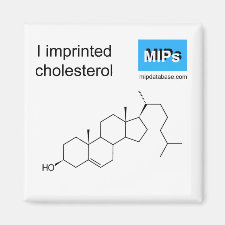
Authors: Hwang CC, Lee WC
Article Title: Chromatographic characteristics of cholesterol-imprinted polymers prepared by covalent and non-covalent imprinting methods.
Publication date: 2002
Journal: Journal of Chromatography A
Volume: 962
Issue: (1-2)
Page numbers: 69-78.
DOI: 10.1016/S0021-9673(02)00559-9
Abstract: Cholesterol-imprinted polymers were prepared in bulk polymerization by the methods of covalent and non-covalent imprinting. The former involved the use of a template- containing monomer, cholesteryl (4-vinyl)phenyl carbonate, while the latter used the complexes of template and functional monomer, methacrylic acid or 4-vinylpyridine prior to polymerization. Columns packed with these molecularly imprinted polymers (MIPs) were all able to separate cholesterol from other steroids. For different combinations of cholesterol and beta-estradiol concentrations in a total of 1 g/l, the peak retention times for both compounds were nearly constant. The adsorption capacity for cholesterol onto the MIPs was found to significantly depend on the use of functional monomers, but the selectivity factors were only slightly different from each other at 2.9 to 3.2 since the separation was all based on the specific binding of cholesterol to recognition sites formed on the imprinted polymers. The capacity factors for cholesterol were determined to be 3.5, 4.0 and 3.1, respectively, for covalently imprinted, 4-vinylpyridine-based, and methacrylic acid-based non-covalently imprinted polymers. However, the covalently imprinted polymer was found to have a higher adsorption capacity for cholesterol and about fivefold higher chromatographic efficiency for cholesterol separation, in comparison with non-covalently imprinted polymers. The use of covalent imprinting significantly reduced the peak broadening and tailing. This advantage along with constant retention suggests that the covalently imprinted polymer has potential for quantitative analysis. (C) 2002 Elsevier Science B.V. All rights reserved



Join the Society for Molecular Imprinting

New items RSS feed
Sign-up for e-mail updates:
Choose between receiving an occasional newsletter or more frequent e-mail alerts.
Click here to go to the sign-up page.
Is your name elemental or peptidic? Enter your name and find out by clicking either of the buttons below!
Other products you may like:
 MIPdatabase
MIPdatabase









